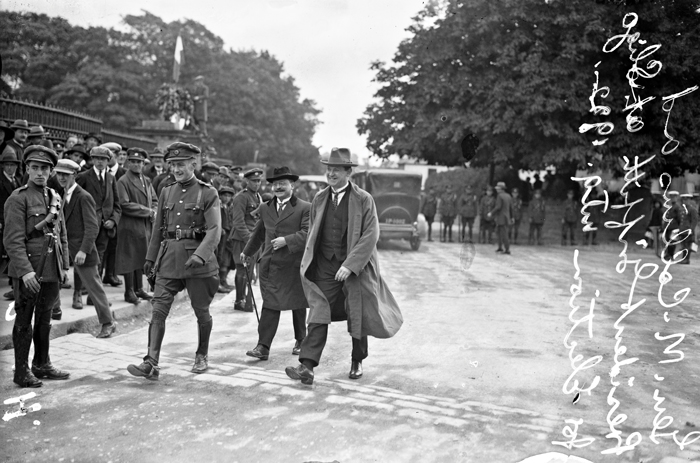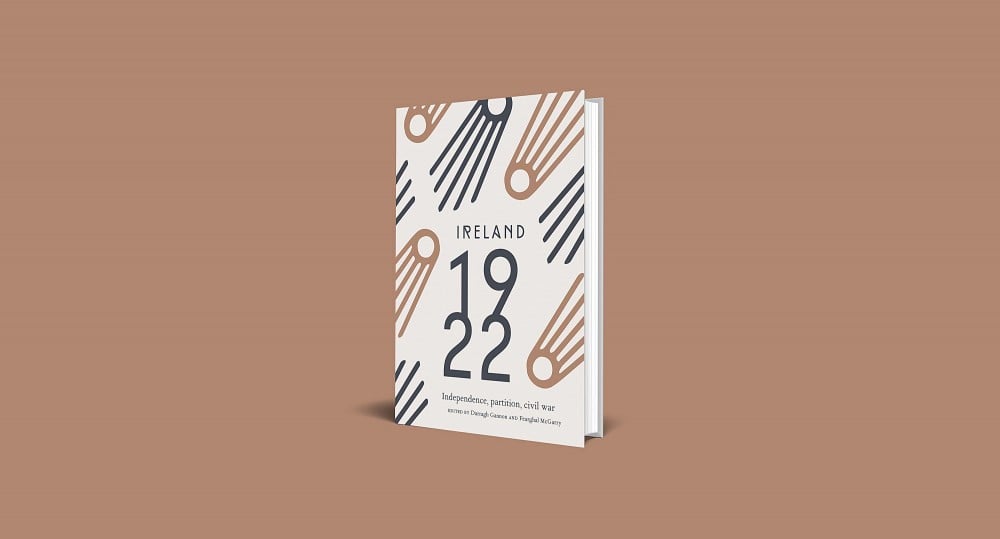12 August 1922: Death of a Statesman
Transient Eminence: The Fading of Arthur Griffith
By Eunan O’Halpin
Arthur Griffith’s sudden death at the age of just 51 on 12 August 1922 was an enormous shock to his Provisional Government colleagues and to Treaty supporters in Ireland and beyond. A printer and jobbing political journalist, he lived and died a poor man: his widow had to fight for adequate state support for his young family.¹ Michael Collins died less than a fortnight later; ever since, Griffith’s death has been addressed largely as a prelude to the ‘Big Fellow’s’ dramatic end. Collins’s death still overshadows Griffith’s memory, clouds the reality that Griffith’s death was world news when it happened, and hampers evaluation of how Griffith might have influenced national economic development in succeeding years.
Founder of Sinn Féin and populariser of separatist arguments based on economic as well as political grounds, Griffith in 1919–20 was left holding the reins of the revolutionary underground Dáil government in Dublin.² Meanwhile President Éamon de Valera squandered nineteen months on a diplomatically futile American tour. ‘The Chief ’s’ acolytes later dismissed Griffith as an inadequate figure who yielded to temptation during the Treaty negotiations, intoxicated by the chance of seizing the top job. Griffith’s longstanding advocacy of ‘dual monarchy’ was taken as evidence that he was never a thoroughgoing separatist. Yet de Valera’s failed compromise ‘Document No. 2’ was a refinement rather than an abrogation of that approach, because it reserved a limited place for the British Crown in a new Ireland’s constitutional framework.
Griffith was a vigorous and sometimes abrasive defender of the Treaty settlement he had done so much to forge. Others around the Provisional Government table may have regarded the Treaty as the least bad option:not Griffith. When he succeeded Collins as chairman of the Provisional Government after civil war erupted, he bluntly informed an American journalist that ‘the Irish people want peace. They want peace even to the extent of accepting an alliance with Britain’.³
The dominions mourned Griffith as a constructive statesman who turned the necessity of compromise with Britain into a positive element not only in Anglo-Irish but in dominions relations. Some newspapers recalled a man who died disappointed, yet others pointed to his remarkable achievements as a political thinker, from the founding of Sinn Féin to the securing of effective independence for most of Ireland. Most of his political dreams had become reality, the tragic issue of Ulster apart. Australian and New Zealand newspapers lamented the loss of a man of integrity and intelligence. The ‘friends of Ireland in Australia will place a wreath’ on his grave ‘no matter what their politics may be…his good faith has been as conspicuous as his courage’.⁴ The South African leader General Smuts, who had helped clear the way for the truce of July 1921, termed Griffith ‘quite the strongest man of the Sinn Féin party’.⁵
In New York, Griffith was described as ‘the brain of the Irish movement for freedom’, and de Valera’s antagonist, Judge Daniel Cohalan, mourned
one of the greatest men of his generation, the father of Sinn Féin and a scholar…I believe the work in Ireland will go on. His work and life will be an inspiration…I know he felt that the Free State was only a step towards ultimate freedom.⁶
The New York Tribune said of him that ‘beloved of no one class, the rock of the revolution had come to be respected by all, from the somewhat frightened old Unionists of the Kildare Street club to the impatient youths in the Free State green’. Another newspaper accorded Griffith’s death a banner headline and a collage of three photographs, one of him walking with his two children. His passing was discussed not only in major urban newspapers, but in obscure small towns such as Paragould, Arkansas, and Hartford, Kentucky, while his image appeared on the front page of the Capital Journal of Salem, Oregon.⁷ Reporters wrote of the enormous crowds that assembled in Dublin to pay their respects as his funeral procession passed. Newsreels, one inaccurately terming him ‘first President of the Irish Free State’, recorded the occasion.
Expressions of regret from King George V and the British Cabinet reflected genuine feeling. In British eyes Griffith had become the embodiment of reasonableness in discourse and negotiation. He traded on this to secure acceptance, with very limited and symbolic elements of fealty to the Crown as required under the 1921 Anglo-Irish Treaty, of the draft constitution of the Irish Free State. That constitution was secular and democratic in the institutions it prescribed. It also, albeit unintentionally, turned out to prove a significant stepping stone towards complete independence: it was under its provisions that from 1932 de Valera was able successively to remove the elements of subjugation most obnoxious to republicans.
Lord Birkenhead, who sparred with Griffith during the Treaty negotiations, praised a remarkable man, ‘dour and placid’ but ‘courageous and honest’, who ‘perished of sheer exhaustion and overwork’. It is difficult to say if hard work was a decisive factor, on a par with his heavy smoking and lack of exercise.⁸ Fourteen men served as ministers of the Dáil and Provisional governments between January and December 1922. Excluding Michael Collins (shot in 1922, aged 31), Kevin O’Higgins (shot in 1927, aged 35) and Patrick Hogan (killed in an accident in 1936, aged 45), five died in their eighties, two in their seventies, two in their sixties, and only two, including Griffith, as early as their fifties. This was despite the imprisonment, hardship and the threat of violent death all experienced from 1916 onwards.
In February 1922 Lord Midleton commended Griffith’s understanding of the concerns of southern unionist landowners, and in May the Provost of Trinity College contrasted Griffith with Michael Collins, who had not ‘kept faith’. Griffith came to be seen as a moderate on Northern Ireland: upon news of his death, a unionist grandee on Derry Corporation proposed a vote of sympathy.⁹ Yet his sensitivity towards minority concerns in the emerging Irish Free State was not matched by insistence upon legislative measures to protect the long-term interests of the nationalist minority in newly created Northern Ireland.
Had death not intervened, Free State economic policy under President Griffith might have been far more ambitious and adventurous, and less in thrall to conventional thinking than under his more conservative and fiscally orthodox successor W.T. Cosgrave. The paradox is that his key ideas were embraced most enthusiastically not by his pro-Treaty allies, but by his civil war opponents under de Valera in the 1930s. Popular memory, dazzled by the glamour of Michael Collins and fascinated by the enigmatic figure of Éamon de Valera, overlooks how important a political leader Griffith was when he died, and how influential his ideas remained in both constitutional and economic affairs. Of the key thinkers and actors who re-invented Irish nationalism at the turn of the twentieth century and who achieved separation from Britain, only Bulmer Hobson (1883–1969) has fared worse in public memory than the stocky bowler-hatted printer, polemicist, ideologue and statesman Arthur Griffith.
Extracted from Ireland 1922 edited by Darragh Gannon and Fearghal McGarry and published by the Royal Irish Academy with support from the Department of Tourism, Culture, Arts, Gaeltacht, Sport and Media under the Decade of Centenaries 2012-2023 programme. Click here to view more articles in this series, or click the image below to visit the RIA website for more information.






















